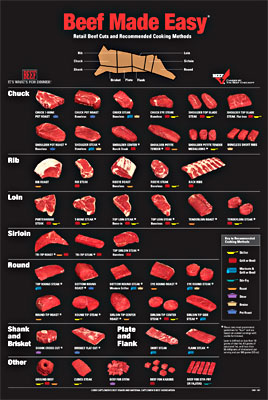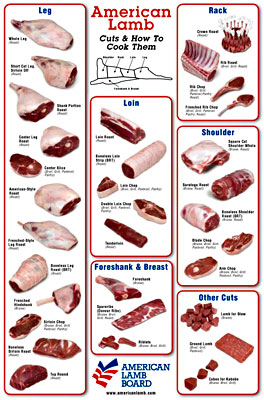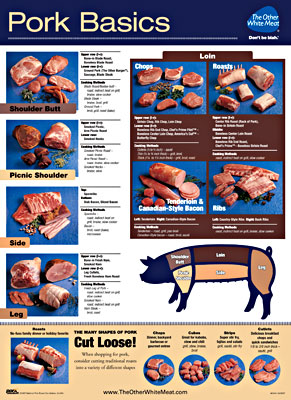 |
| Beef Made Easy Cut Chart used with permission of the National Cattlemen’s Beef Association. |
Talking to Your Butcher
By Diane Schivera, M.A.T.
When you bring animals to be processed, you need to have a clear understanding with your butcher to get the product you desire. You need to know the terms being used, and you must recognize which part of the animal will produce each retail cut – the “bits” you will bring home to cook or sell to customers.
The major sections of the carcass are called primal cuts. When selling to restaurant chefs who prefer to cut their own meat, you sell primal cuts.
Processing Terms
Carcass cutting yield, the percentage of the carcass weight that results in retail cuts, varies from 30 to 50 percent, depending on the amount of bone and fat on the retail cuts.
Cooler shrinkage occurs while the carcass hangs in the cooler – commonly seven to 10 days for beef, three days for lamb and 4 to 12 days for pork. The fat cover over the carcass reduces shrinkage.
Cut sheet is the list of possible retail cuts your butcher offers. If you want anything other than these, explain that clearly to your butcher. You and the butcher may be using a different name for the same piece.
Finished cut weight is the amount of meat in retail cuts that is produced from the animal.
Dressing percentage is the percentage of the carcass compared to the weight of the live animal, or (hot carcass weight/live weight) x 100. This number is affected by what is included in the carcass weight, the species, and the amount of fat and muscle on the animal. Averages are 61 percent for beef cattle, 59 percent for dairy steers and 72 percent for hogs.
 |
| Lamb Cuts, used with permission of the American Lamb Board. |
Hanging weight or carcass weight is the weight of the animal after it has been dressed, i.e., after the initial slaughtering and processing. Different processors may define this term differently. One may use the weight after the head, hide, offal (discarded internal parts), lower shank bones and internal organs are removed; another may include the head, the internal organs or both. A head on hide off carcass includes the head, offal and internal organs. Organs hanging means the liver, heart and kidneys with surrounding fat are included.
Hot carcass weight is the weight of the animal immediately after slaughter.
To calculate how much meat you’ll receive, use this equation:
Live weight x dressing percentage x carcass cutting yield = pounds of meat.
For example, a 280-pound hog butchered to bone-in chops and roasts, well trimmed, and regular ground pork or sausage will yield
280 x (0.72 x 0.74) = 280 x 53% = 148 pounds of meat.
A 280-pound hog butchered to boneless chops and roasts, closely trimmed, and lean ground pork or sausage will yield
280 X (0.72 x 0.65) = 280 x 47% = 132 pounds of meat.
Shrinkage – the weight the animal loses during shipping – can be affected by the length of shipping time and the animals’ feed before shipping. Animals may have been on lush pasture, fed dry hay (which stays in the gut longer) or deprived of feed. Farmers commonly withhold feed but not water for a short period before slaughter to reduce the amount of food in the gut and the potential for contamination.
The accompanying posters show the primal cuts for beef, pork and lamb. Some terms are similar but many are different. Next to each primal cut is a list of retail cuts that can come from that section. This is the “cut sheet” your butcher will provide. Be aware that different processors will have their own cut sheets.
 |
| Pork Basics used with permission of The National Pork Board. |
Also, remember that if you get pork loins cut into loin chops, you cannot also get a loin roast from the same section of the animal. Likewise, with beef tenderloin, if you ask the butcher for a large filet mignon, you will not be able to get T-bone steaks or porterhouse steaks, because these include a bit of the tenderloin.
You must also tell the butcher how many of each part you want in each package. You probably don’t want all the sirloin steaks in one package – unless you are planning a big party!
Resources
Deborah Krasner’s book Good Meat: The Complete Guide to Sourcing and Cooking Sustainable Meat (Stewart, Tabori & Chang, 2010) reportedly contains a tutorial on cut sheets and butchering from the perspective of consumers who buy whole or half grass-fed beef carcasses.
www.meatshop101.com A complete website about beef, pork, lamb and chicken
www.extension.org/pages/Local_Meat_Buying_Guide
www.vermontnaturalbeef.com/site/cut_descrip.php
www.americanlamb.com/lamb101/cuts.aspx American Lamb Board
www.pork.org National Pork Board
www.beefboard.org National Beef Board
About the author: Diane Schivera is MOFGA’s organic livestock specialist. You can contact her with your questions at 568-4142 or [email protected].

